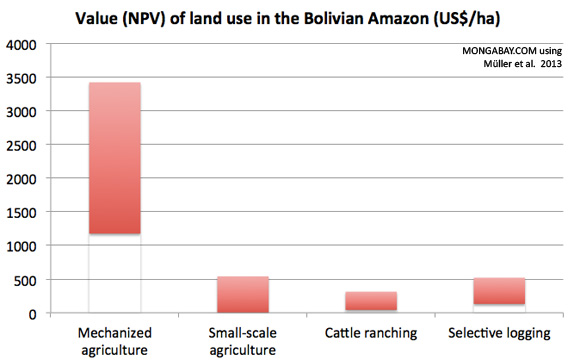
Bolivia should prioritize environmental law enforcement and slowing expansion of large-scale cattle ranching to reduce Amazon deforestation, argues a study published last month by researchers from Germany and the Center for International Forestry Research (CIFOR).
Robert Mueller of Goettingen University and colleagues analyzed trends in land use change in Bolivia between 1992 and 2004. They found that industrial agriculture was the biggest driver of deforestation in Bolivia, amounting to 54 percent of land clearing. Cattle ranching, at 27 percent, and small-holder agriculture, at 19 percent, followed.
But agriculture is a difficult target for programs that aim to reduce emissions from deforestation and degradation (REDD+) because it generates more than half a million jobs (150,000 from commercial agriculture and 400,000 from small-holder farming) and accounts for more than 12 percent of exports. Instead, the scientists say that cutting forest conversion for low-productivity cattle ranching would be a better use of conservation resources.
“[Cattle ranching] should be targeted as a priority since its expansion threatens forests in many different locations and improvements could be achieved at relatively low costs,” they write.

Mueller and colleagues argue that better enforcement of existing land use legislation — specifically a 1996 regulation which established fees for deforestation permits — is one potential approach to reducing deforestation for cattle ranching. Presently the law is poorly enforced (80 percent of ranches between 2002 and 2006 were not in compliance) and fees for deforestation — when collected — are only $15 per hectare.
Noting that 11 people are presently responsible for monitoring forest activities across 6 million hectares in Pando, a major deforestation hotspot, the authors suggest boosting staff levels of the agency charged with enforcing the land use regulation (the Autoridad de Fiscalización y Control Social de Bosques y Tierras or ABT) could pay immediate dividends. Streamlining Bolivia’s land-titling program could also help by reducing the practice of clearing forest to establish land claims.
Overall Mueller and colleagues conclude that “there is significant potential for reducing deforestation in lowland Bolivia without causing significant negative impacts on the country’s economic welfare.”
“Tackling cattle ranching offers the best opportunities for effective and efficient deforestation reduction. The enforcement of existing legislation could particularly prevent large illegal clearings caused by a relatively small number of cattle ranchers.”
The conclusions suggest a path toward cost-effectively reducing deforestation in Bolivia whether or not the government opts to participate in a global REDD+ program. In international climate discussions, Bolivia has expressed opposition to any program that involves carbon offsets or markets. These mechanisms presently figure into the REDD+ program being advanced by the U.N.
CITATION: Robert Müller, Till Pistorius, Sophia Rohde, Gerhard Gerold, Pablo Pacheco. Policy options to reduce deforestation based on a systematic analysis of drivers and agents in lowland Bolivia. Land Use Policy 30 (2013) 895–907
Related articles